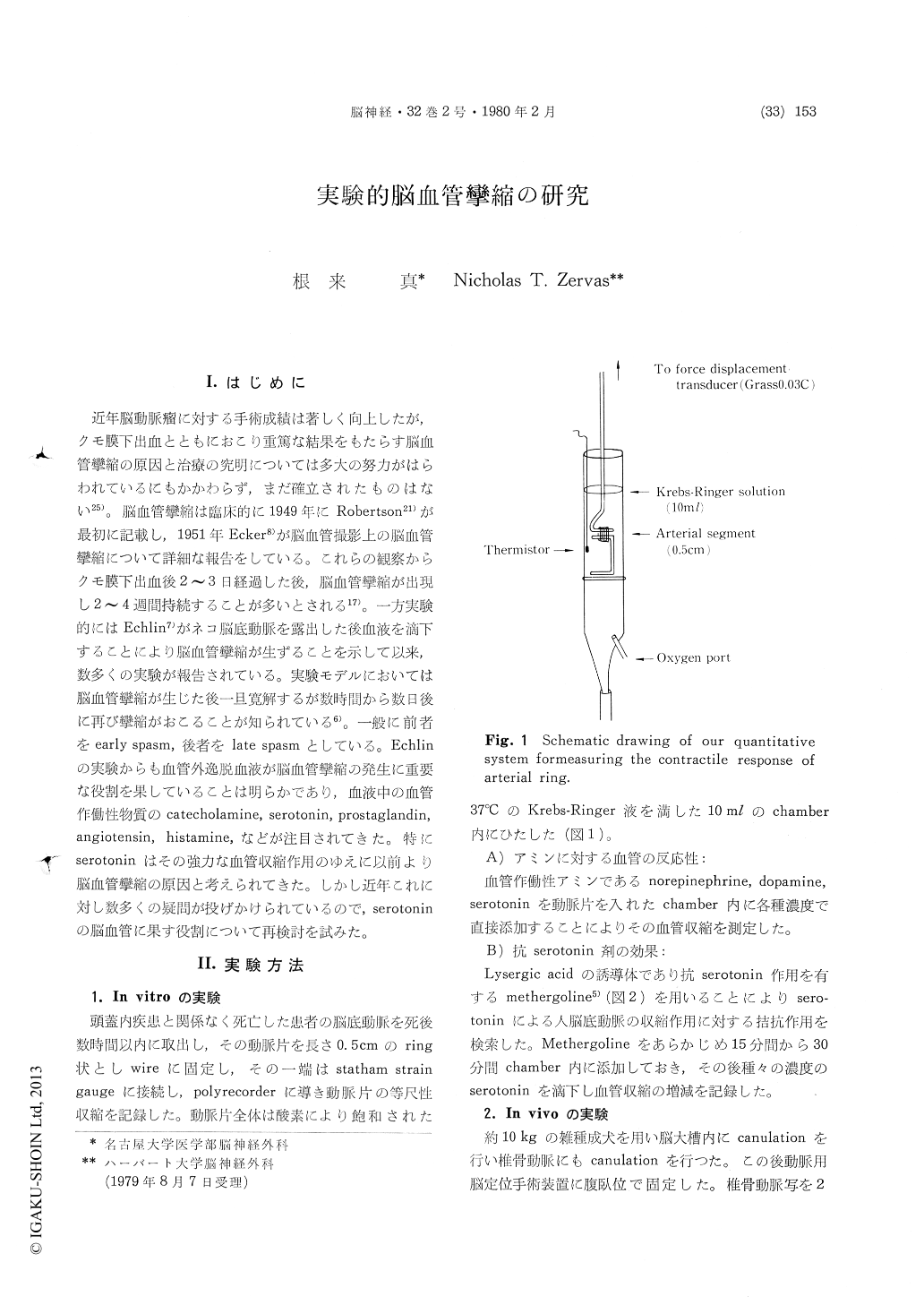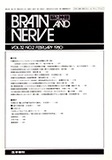Japanese
English
- 有料閲覧
- Abstract 文献概要
- 1ページ目 Look Inside
Ⅰ.はじめに
近年脳動脈瘤に対する手術成績は著しく向上したが,クモ膜下出血とともにおこり重篤な結果をもたらす脳血管攣縮の原因と治療の究明については多大の努力がはらわれているにもかかわらず,まだ確立されたものはない25)。脳血管攣縮は臨床的に1949年にRobertson21)が最初にに記載し,1951年Ecker8)が脳血管撮影上の脳血管攣縮について詳細な報告をしている。これらの観察からクモ膜下出血後2〜3日経過した後,脳血管攣縮が出現し2〜4週間持続することが多いとされる17)。一方実験的にはEchlin7)がネコ脳底動脈を露出した後血液を滴下することにより脳血管攣縮が生ずることを示して以来,数多くの実験が報告されている。実験モデルにおいては脳血管攣縮が生じた後一旦寛解するが数時間から数日後に再び攣縮がおこることが知られている6)。一般に前者をearly spasm,後者をlate spasmとしている。Echlinの実験からも血管外逸脱血液が脳血管攣縮の発生に重要な役割を果していることは明らかであり,血液中の血管作働性物質のcatecholamine,serotonin,prostaglandin,angiotensin,histamine,などが注目されてきた。特にserotoninはその強力な血管収縮作用のゆえに以前より脳血管攣縮の原因と考えられてきた。しかし近年これに対し数多くの疑問が投げかけられているので,serotoninの脳血管に果す役割について再検討を試みた。
Cerebral vasospasm is a serious and distinct entity with frequent disastrous consequnce due to cerebral ischemia, edema and infarction.
Numerous investigative works were carried out for clarifying its pathogenesis. In recent years, it has been known that the factors responsible for vasospasm are contained in blood and released into CSF at the site of subarachnoid hemorrhage. The object of this investigation was to determine whether vasoactive amines in blood such as sero-tonin played an active role in the production of vasospasm following subarachnoid hemorrhage.
The contractivity of cerebrovascular smooth muscle in response to specific vasoactive agents likedopamine, norepinephrine and serotonin was meas-ured in a controlled quantitative system using human basilar artery. In this experiment 0.5 cm length ring of artery was mounted on the wire and bathed in the chamber containing Krebs-Ringersolution.
The degree of constriction was recorded by strain gauge. Methergoline, derivative of lysergic acid, was also tested for its antagonistic effect toward serotonin. Among them, serotonin caused strong and reproducible vasoconstriction directly related to dose. Methergoline was turned out to be a potent serotonin antagonist. Vasoconstricting pro-perty of serotonin in vivo was also examined. Cisterna magna infusion of serotonin carried out in 7 dogs. The diameter of basilar artery was measured angiographically before and after infus-ion. Transient vasoconstriction (-30%) was ob-served after serotonin infusion, but vessel diameter returned to previous state within 30 minutes.
In another in vivo experiment, vasospasm of basilar artery in dog was induced by injection of blood into cisterna magna. The diameter of basilar artery was measured as previously stated.
After confirmation of presence of vasospasm among eleven dogs, methergoline was employed toreverse vasospasm through various routes such as intravenous, intra-arterial and intra-thecal.
Vertebral angiography was repeated at 15, 30, 60, 120 minutes after methergoline administration. Pre-existing blood-induced vasospasm (-30% to -50%) could not be reversed by methergoline in any of dogs. Systemic effect of methergoline was minimal in any routes.
In summary, in vitro experiment among tested vasoactive amines, serotonin induced strong vaso-constriction on human basilar artery. In vivo ex-periment serotonin-induced vasoconstriction last only less than 30 minutes. This is partly because monoamine oxidase rapidly catabolize serotonin. Methergoline, a potent serotonin antagonist, failed to reverse blood-induced vasospasm in dog. It might be concluded that serotonin itself has active role in acute stage of vasospasm, but in its chronic stage additional factors must be considered.

Copyright © 1980, Igaku-Shoin Ltd. All rights reserved.


